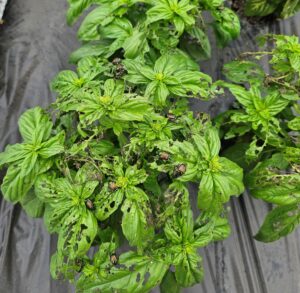Last week I encountered my first adult Japanese Beetle of the 2023 season. It was at my home, and I was keeping my fingers crossed that it was just an unlucky stray individual, but hoping I had more time before their devastation would arrive. Well, I was wrong.
Over the weekend, I found a few more in my black raspberries, and then when visiting our high tunnels at the Meigs Horticulture Research Farm in Lafayette on June 26, reality set in. This year we have some fun companion plants in our high tunnel tomato project and one of which happens to be basil. I don’t know why, but I will agree with the beetles that basil is tasty! Unfortunately, they don’t share well. As you can see, the plants are being devoured (Figure 1).
While this beetle, in its adult stage, is known to feed on over 250 different plants, there always seem to be a few horticultural crop favorites. Depending on the plant, the damage may be tolerable. For instance, if the feeding is restricted to the vegetation on a fruiting crop we can still get some harvest. However, when they are feeding on the foliage that we also want to eat, it becomes unappetizing quite quickly. This species undergoes complete metamorphosis, meaning the immature stage looks nothing like the adult. In fact, they feed in very different habitats and host plants. The immature larva, or grub as they are called, feeds on the roots of turf grass species. They pupate in this substrate, and when the adults emerge, they travel great distances. This is where they become a problem of a different sort. Rather than killing patches of lawn, they destroy food and landscape plants.
Management of the adult stage is difficult. No matter what, we do not recommend trying to catch them with Japanese beetle traps. The smell is so enticing that you will actually pull from your neighbors, which I don’t think you want. Regardless of how hard you try to be the ‘good neighbor’, no one is that nice. For more information on how to manage this pest in turf and on ornamentals, read Extension Bulletin E-75. In vegetables, our best tool is pyrethroids, but this only offers temporary knockdown. Alternatively, there are some organophosphates labeled for particular crops, but these are highly toxic compounds that I don’t recommend. This pest still has all of us pulling our hair out! I get satisfaction in my own garden pulling them off and throwing them into a bucket of soapy water!
